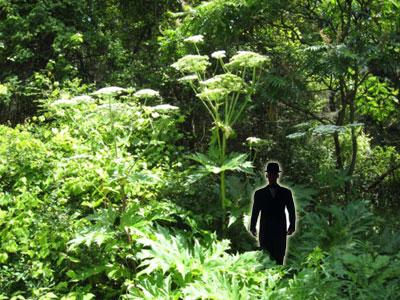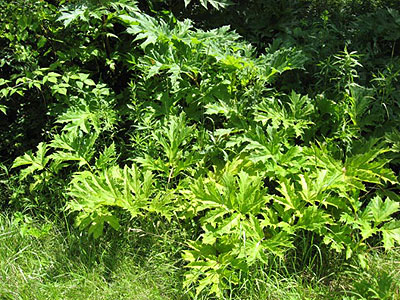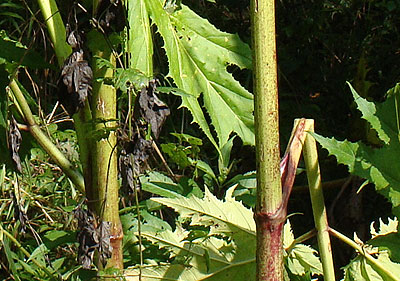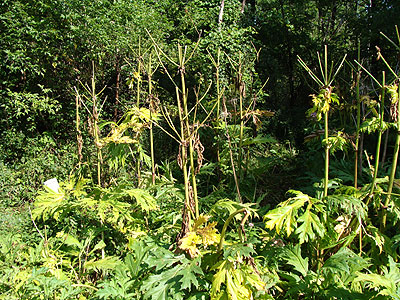- By Dan Veaner
- News
 Print
Print  Since the Lansing Star first reported on Giant Hogweed on July 17 the Lansing Highway Department has received at least a dozen calls from people asking about the poisonous plant. Highway Supervisor Jack French says that while giant hogweed looks a lot like Queen Anne's lace, it is easy to tell the two apart once you know what you are looking for.
Since the Lansing Star first reported on Giant Hogweed on July 17 the Lansing Highway Department has received at least a dozen calls from people asking about the poisonous plant. Highway Supervisor Jack French says that while giant hogweed looks a lot like Queen Anne's lace, it is easy to tell the two apart once you know what you are looking for. "We've probably had a dozen calls from people telling us they think they've got hogweed, and from people who have hogweed," he says. "A lot of people see that, especially in your paper and the Journal. It does look like Queen Anne's Lace, but you can't tell the size of it."

This picture shows how tall giant hogweed can grow.
(photo courtesy of Lansing Highway Department)
| Our July story on Giant Hogweed in Dryden attracted a good four times our usual readership in the first week alone. The picture in that article didn't begin to give a sense of how big these plants are. Monday Lansing Highway Superintendent Jack French drove me down to Niemi Road in Dryden to see what is left of the plants there after the DEC cut the flowers off and sprayed them. Even with half of their height gone I was struck by how enormous these plants grow in a single season. The ones I saw had grown to 15 feet before the DEC got to them. Jack pointed out the distinctive, bushy leaves, explaining that they appear before the stems and flowers, and are a good indicator that the plant is really hogweed. | ||
But the feature that French points to as distinctly hogweed is its large pointy, veined leaves. On Niemi Road in Dryden he points to clusters of the leaves in ditches. He says the leaves grow even before the stems and flowers, and are a dead giveaway that Hogweed is growing.
Giant hogweed is very persistent and aggressive. The flowers make pollen that is filled with water now, but when it dries later in the season it is carried through the air and in stormwater runoff in ditches and streams. An average plant can produce 20,000 seeds, but some have produced as many as 100,000.
Exposure to both the plant and sunlight can cause a skin inflammation called 'phytophotodermatitis.' Painful blisters form within 48 hours and become dark splotches or scars that can last between a few months and six years. If the sap gets into your eyes blindness may result.

Hogweed leaves are bushy, pointed, and veined
(photo courtesy of Lansing Highway Department)
French says that the New York State Department of Environmental Conservation (DEC) maintains two teams that are entirely devoted to controlling Giant Hogweed. He says DEC officials told him the Niemi Road infestation is among the worst they have seen. Most of the Giant Hogweed in New york is in the western portion of the state. There are between 16 and 25 known sites in Tompkins County. That is about average for the counties in the state that have giant hogweed. Erie County has the most with more than 50 sites reported.
The DEC offers has guides on their site with detailed explanations of how to identify the plant (click here for the DEC Giant Hogweed Fact Sheet. They say that giant hogweed looks like Queen Ane's Lace with attitude, but it can also be confused with benign and less poisonous plants including cow parsnip, purple-stemmed Angelica, poison hemlock, and wild parsnip.

Stems have purple splotches and stiff hairs
French says there have been credible reports in Lansing of hogweed growing on Arrowood Drive, just south of the Tompkins Ithaca Regional Airport on the south side of Route 13.
"It is growing in two places on Arrowood Drive," French says. "The people that live there say it's been there for at least five years. They originally had the DEC come in and spray. The DEC uses a more potent Roundup. Both people who called say they spray every year now when they see it start to come up. They killed it for that one year, but it keeps coming back."
French says that others have called thinking they may have seen giant hogweed. "Some calls from people concerned that they thought they saw hogweed on Salt Point or Myers Park," he says. "I couldn't find any. I'm not saying that it's not there."

The DEC cut the flowers off the hogweed on Niemi Road
as part of a program to try to keep it from reproducing
Giant Hogweed is so persistent that it takes at least five years to get rid of it. The plants on Niemi Road were about 15 feet tall until DEC experts cut the tops off, including the flowers. That and a special version of Roundup are part of a program to eradicate the plant. The DEC also offers detailed advice on controlling giant hogweed on their Web site .
----
v5i32



